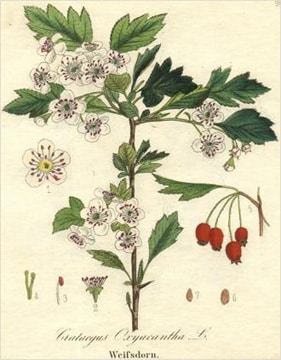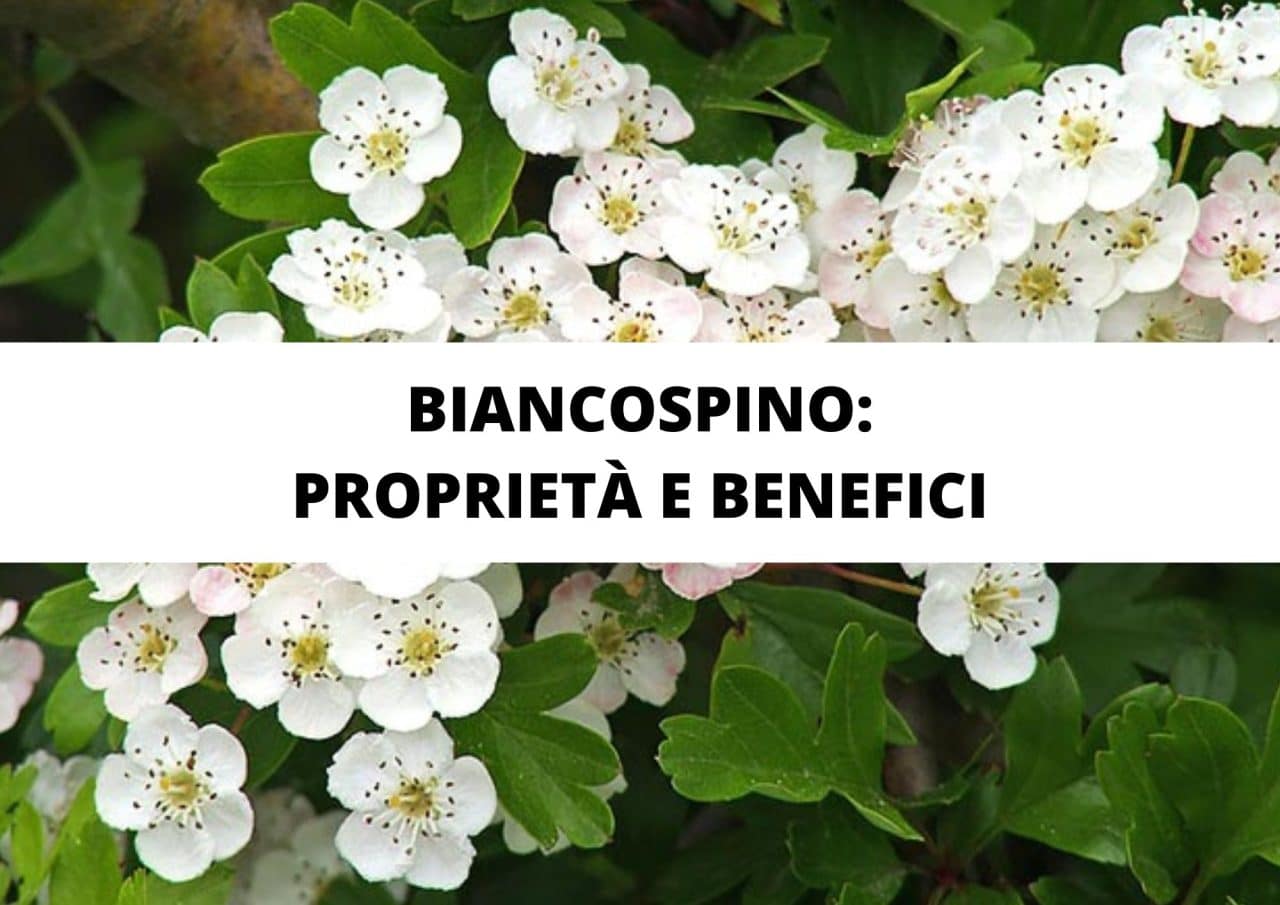The Hawthorn (Crataegus Oxyacantha)is a
shrub
or a small
tree
much branched, twisted and thorny, belonging to the
family
of
Rosaceae
.
The hawthorn has always been known as the heart plant, useful for supporting cardiovascular function, and is known in herbal medicine and phytotherapy for its i
potensive, cardiotonic, vasodolatadric, antispasmodic and sedative
.
Let’s find out more about it
Hawthorn Mother Tincture: benefits and properties
Table of Contents
Crataegus Oxycantha, what is it?
The
Crataegus Oxycantha
is a common shrub, small in size, that grows wild in temperate areas of the northern hemisphere.
It can be found throughout Italy (including islands), especially in undergrowth, on the edges of wooded areas and in wooded pastures, as it has a preference for wetter soil and cooler environments.
The plant is characterized by The
stem
covered with a
bark
Compact, gray in color. I
branches
young ones are instead equipped with
thorns
Developing at the base of the short twigs. On the thorny twigs (pitchers) buds and flowers are born in spring. I
fruits
are oval, red when ripe, about 1 cm in size and with a stone containing the
seed
.
In phytotherapy and herbal medicine, for the preparation of products, the
flowers and leaves of the hawthorn tree
, rich in bioactive compounds.

The chemical composition of Hawthorn:
In phytotherapy the
Hawthorn
is often used in the form of Mother Tincture to best extract its active ingredients, using its leaves and flowers, which contain a phycomplex consisting of:
- Flavonoids (hyperoside, vitexin, luteolin, rutin, quercetin, apigenin)
- Leucoanthocyanidins
- Pentacyclic triterpene acids (ursolic, crategolic, oleanolic, acantholic, neotegolic acids)
- Phenolcarboxylic acids
- Sterols
- Amines and aminopurines
Working in synergy, the combination of these constituents is responsible for the properties and action of this remedy.
Properties and benefits of Hawthorn:
Testimonies on the
medicinal use of hawthorn
are already found in Theophrastus, Dioscorides, in the
Materia Medica
of the Tang Dynasty (Tang bencao), dating from 659 AD (the world’s earliest known official pharmacopoeia),[3] and then in the Vulgar Age in Mattioli.
The hawthorn has always been known as “
the plant of the heart”
, useful for supporting cardiovascular function and is known in herbal medicine and phytotherapy for its i
potensive, cardiotonic, vasodolatadric, antispasmodic and sedative
.
From the dried flowers and leaves of the
Hawthorn
flavonoids and proanthocyanidols are in fact obtained. The former, we know, and they are powerful antioxidants and free radical “scavengers,” useful in the prevention of cardiovascular and inflammatory diseases. In addition, they would also appear to possess some antimicrobial, antiviral and cytotoxic activity.
Proanthocyanidols, on the other hand, are part of a family of polyphenols that have functions that are
cardioprotective, sedative and antiradical
.
La
Hawthorn Mother Tincture
thus proves to be a natural remedy that finds use especially in disorders of the cardiovascular system such as arrhythmias and high blood pressure.
However, it can also be useful In cases of digestive problems that cause abdominal pain, to relieve menstrual pain, for ‘insomnia, for mood disorders, particularly anxiety states.

Hawthorn Mother Tincture: ministerial claims:
La
Alcohol-Free Mother Tincture of Hawthorn
, o
Hawthorn Glyceric Macerate
, is a natural remedy for which these properties can be claimed:
- Useful for regulating the function of the cardiovascular system
- Useful for regulating blood pressure
- Also useful for relaxation and mental well-being.
All of these claims are regulated and approved by the Italian Ministry of Health for their physiological effects, aimed at “optimizing the body’s functions within homeostasis.”
Hawthorn Mother Tincture
Mother tincture (TM) is a liquid preparation, obtained by extracting the fresh drug by
percolation
o
maceration
with an appropriate solvent.
The solvent most used in mother tinctures is a hydroalcoholic solution (water + alcohol) with a variable alcohol content (most often between 60 ° and 80 °) depending on the solubility of the active ingredients to be extracted.
La Hawthorn Mother Tincture is an herbal preparation extracted from the leaves of Centella Asiatica, which are macerated in the 1:10 ratio in a solution of water and Alcohol. It is an herbal remedy believed to be useful for its anti-inflammatory, hypotensive and beneficial properties on vessels and connective tissue, and which is widely used in Phytotherapy.

Hawthorn Glyceric Macerate: what it is
In recent years, Mother Tinctures extracted with the Vegetable Glycerin instead of Alcohol, which makes them better in several respects. In addition, since Glycerin is a less potent type of solvent and therefore less extractive than Alcohol, innovative extraction techniques are used, such as the‘Ultrasonic Extraction..
Ultrasonic extraction is an innovative, clean, quick and easy extraction technique that allows to
extract the active ingredients from plants and medicinal plants in particular and to make quality phytoextracts
, taking advantage of the exclusively mechanical action exerted by the cavitation effect produced by sound waves.
La
Hawthorn Mother Tincture
is obtained by hydro-glyceric maceration of the aerial parts of Centella, again at a ratio of 1:10, and is an innovative type of Mother Tincture, which, having been obtained by the ultrasonic process, makes it better from several points of view.
We at Vonderweid, thanks to our 20 years of experience in the field of dietary supplements and after a long process of research and development in our laboratories for the production of
Non-alcoholic Mother Tinctures
, we have managed to obtain a product with the desired characteristics.
Our non-alcoholic mother tinctures are classified as.
Dietary Supplements
and are regularly notified to the
Ministry of Health
.
Hawthorn, how many drops to take?
For the intake of Hawthorn in drops , we recommend the use of 40 drops dissolved
In a glass of water, 1-3 times a day.
Taking 40 drops of Vonderweid Hawthorn Mother Tincture 3 times a day (120 drops total) is equivalent to taking 753 mg of Hawthorn.
Always remember Not to exceed the recommended daily dose. Keep out of the reach of children under 3 years of age. Dietary supplements should not be understood as a substitute for a varied and balanced diet and healthy lifestyle, and we always recommend the advice from your doctor or nutritionist before taking.
The advice, therefore, is to always consult your primary care physician before starting to take St. John’s Wort mother tincture, then consult a good herbalist or herbal medicine expert to determine how to take St. John’s Wort tincture and in what amounts.





